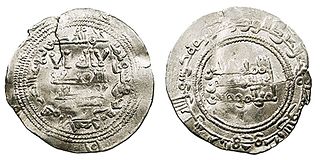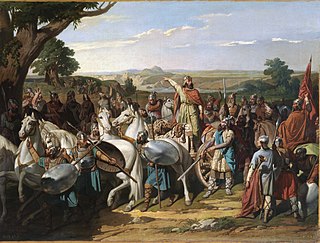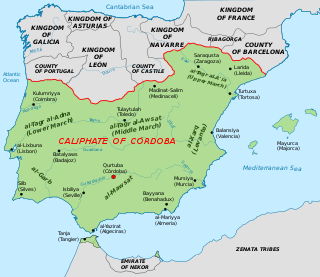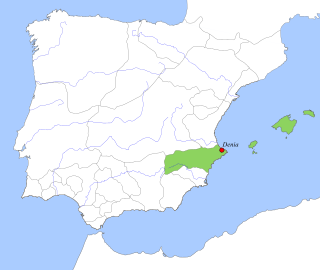Related Research Articles

Abd al-Rahman I ibnMu’awiya was the founder of the Umayyad dynasty that ruled the greater part of Iberia in Al-Andalus for nearly three centuries. Abd al-Rahman was a member of the Umayyad dynasty in Damascus, and his establishment of a government in Iberia represented a break with the Abbasids, who had overthrown the Umayyads in Damascus in 750.

ʿAbd al-Raḥmān ibn Muḥammad ibn ʿAbd Allāh ibn Muḥammad ibn ʿAbd al-Raḥmān ibn al-Ḥakam al-Rabdī ibn Hishām ibn ʿAbd al-Raḥmān al-Dākhil, or simply ʿAbd al-Raḥmān III, was the Umayyad Emir of Córdoba from 912 to 929, at which point he founded the Caliphate of Córdoba, serving as its first caliph until his death. Abd al-Rahman won the laqab (sobriquet) al-Nāṣir li-Dīn Allāh in his early 20s when he supported the Maghrawa Berbers in North Africa against Fatimid expansion and later claimed the title of Caliph for himself. His half-century reign was known for its religious tolerance.
Musa ibn Nusayr served as an Umayyad governor and an Arab general under the Umayyad caliph Al-Walid I. He ruled over the Muslim provinces of North Africa (Ifriqiya), and directed the Islamic conquest of the Visigothic Kingdom in Hispania.

The Banu Qasi, Banu Kasi, Beni Casi, Banu Musa, or al-Qasawi were a Muladí dynasty that in the 9th century ruled the Upper March, a frontier territory of the Umayyad Emirate of Córdoba, located on the upper Ebro Valley. At their height in the 850s, family head Musa ibn Musa al-Qasawi was so powerful and autonomous that he would be called 'The Third Monarch of Hispania'. In the first half of the 10th century, an intra-family succession squabble, rebellions and rivalries with competing families, in the face of vigorous monarchs to the north and south, led to the sequential loss of all of their land.

Saqaliba is a term used in medieval Arabic sources to refer to Slavs, and other peoples of Central, Southern, and Eastern Europe. The term originates from the Middle Greek slavos/sklavenos (Slav), which in Hispano-Arabic came to designate first Slavic slaves and then, similarly to the semantic development of the term in other West-European languages, foreign slaves in general. The word was often used to refer specifically to Slavic slaves, but it could also refer more broadly to Central, Southern, and Eastern Europeans traded by the Arab traders.
This is a timeline of notable events during the period of Muslim presence in Iberia, starting with the Umayyad conquest in the 8th century.

The Muslim conquest of Spain was an invasion of the Iberian Peninsula by the Umayyad Caliphate that occurred from approximately 710 to 780. The conquest resulted in the defeat of the Visigothic Kingdom and the establishment of the Umayyad Wilayah of Al-Andalus.
The Banu Tujib, the Tujibids or Banu al-Muhajir, were an Arab dynasty on the Upper March of Al-Andalus active from the ninth to the eleventh centuries. They were given control of Zaragoza and Calatayud by the Umayyads as a counterweight to the independence-minded Muwallad nobility of the region. In Zaragoza, they developed a degree of autonomy that served as the precursor to their establishment of an independent Taifa of Zaragoza after the collapse of the Caliphate of Córdoba. They ruled this taifa from 1018 until they were expelled by another Arab dynasty, the Banu Hud, in 1039. An exiled junior line of the family, known as the Banu Sumadih, established themselves as rulers of the Taifa of Almería, which they held for three generations, until 1090.

The Battle of Simancas was a military battle that started on 19 July 939 in the Iberian Peninsula between the troops of the King of León Ramiro II and Cordovan caliph Abd al-Rahman III near the walls of the city of Simancas.

The Taifa of Toledo was an islamic polity (taifa) located in the centre of the Iberian Peninsula in the high middle ages. It was ruled by the Dhulnunids, a Hawwara Berber clan. It emerged after 1018 upon the fracturing of the Caliphate of Córdoba, when the Dhulnunids, already strong in the lands of Santaver, Cuenca, Huete and Uclés, seized control over the city of Toledo, the capital of the Middle March of Al-Andalus. Upon later territorial conquest, the taifa also expanded to the land of Calatrava. It lasted until the Christian conquest of Toledo in 1085.

The taifa of Dénia was an Islamic kingdom in medieval Spain, ruling over part of the Valencian coast and Ibiza. With Dénia as its capital, the taifa included the Balearic Islands and parts of the Spanish mainland. It was founded in 1010 by the Slavic Muslim warlord Mujāhid al-ʿĀmirī.

The Caliphate of Córdoba, also known as the Cordoban Caliphate, or the Second Umayyad Caliphate, was an Arab Islamic state ruled by the Umayyad dynasty from 929 to 1031. Its territory comprised Iberia and parts of North Africa, with its capital in Córdoba. It succeeded the Emirate of Córdoba upon the self-proclamation of Umayyad emir Abd ar-Rahman III as caliph in January 929. The period was characterized by an expansion of trade and culture, and saw the construction of masterpieces of al-Andalus architecture.

The Battle of Paterna took place between the troops of the Kingdom of León, under the command of Ferdinand I of León and Castile, and those of the Taifa of Valencia, commanded by Abd al-Malik ibn Abd al-Aziz al-Muẓaffar. The battle occurred at the same time as the Siege of Valencia, resulted in a victory for the Kingdom of León.

The history of Valencia, one of the oldest cities in Spain, begins over 2100 years ago with its founding as a Roman colony under the name "Valentia Edetanorum" on the site of a former Iberian town, by the river Turia in the province of Edetania. The Roman consul Decimus Junius Brutus Callaicus transferred about 2,000 veteran soldiers who had fought under him to Valentia in 138 BC. Valentia lay in a strategic location near the sea on a river island that would later be crossed by the Via Augusta. Pompey razed Valentia to the ground in 75 BC; it was rebuilt about fifty years later with large infrastructure projects, and by the mid-1st century, was experiencing rapid urban growth with many colonists from Italy.

The Upper March was an administrative and military division in northeast Al-Andalus, roughly corresponding to the Ebro valley and adjacent Mediterranean coast, from the 8th century to the early 11th century. It was established as a frontier province, or march, of the Emirate, later Caliphate of Córdoba, facing the Christian lands of the Carolingian Empire's Marca Hispanica, the Asturo-Leonese marches of Castile and Álava, and the nascent autonomous Pyrenean principalities. In 1018, the decline of the central Cordoban state allowed the lords of the Upper March to establish in its place the Taifa of Zaragoza.
Abu ʾl-Jaysh Mujāhid ibn ʿAbd Allāh al-ʿĀmirī, surnamed al-Muwaffaḳ, was the ruler of Dénia and the Balearic Islands from late 1014 until his death. With the exception of his early and disastrous invasion of Sardinia, his reign was mostly peaceful. His court became a centre of scholarship and literary production and he himself wrote a book about poetry.
Labib al-Fata al-Saqlabi was the founder and first ruler of the Taifa of Tortosa from around AH 400 (1009/1010 CE) to AH 431 (1039/1040). He was a Saqaliba, usually Slavic children that were captured, castrated, sold as slaves in Spain, and educated in the Islamic culture and religion.
Abd al-Malik ibn Umar ibn Marwan ibn al-Hakam, also known as al-Marwani, was an Umayyad prince, general and governor of Seville under the first Umayyad emir of al-Andalus, Abd al-Rahman I. He led two major campaigns in 758 and 774, the first against the previous ruler of al-Andalus Yusuf ibn Abd al-Rahman al-Fihri and the second against the rebellious troops of Seville and Beja. His victories solidified the Umayyad emirate's control of western al-Andalus. His descendants continued to play important political and military roles in the Emirate well into the 10th century.

Jaume I or the Monument to James I is an instance of public art in Valencia, Spain. The monument is topped by an equestrian bronze statue representing James I of Aragon, conqueror of Valencia in 1238 and founder of the Kingdom of Valencia.
Abd al-Malik ibn Abd al-Aziz al-Muzaffar was the king of the Taifa of Valencia between 1061 and 1065. He was the son of Abd al-Aziz al-Mansur.
References
- ↑ Sanz, Vicente Coscollá (2003). La Valencia musulmana (in Spanish). Carena Editors, S.l. p. 2. ISBN 978-84-87398-75-9.
- ↑ Fletcher, Richard A. (1991). The Quest for El Cid. Oxford University Press. ISBN 978-0-19-506955-6.
- ↑ Calatayud, Mariano Torreño (2005). Arquitectura y urbanismo en Valencia (in Spanish). Carena Editors, S.l. p. 12. ISBN 978-84-96419-08-7.